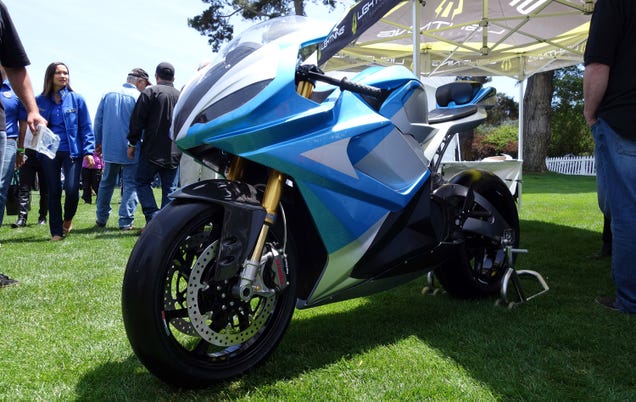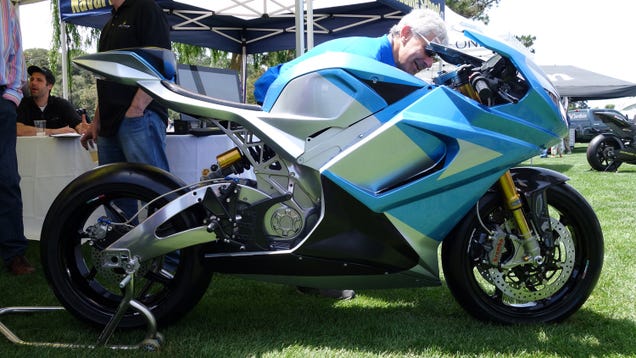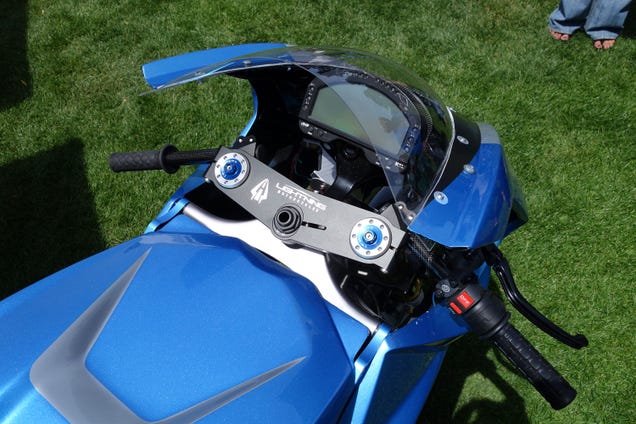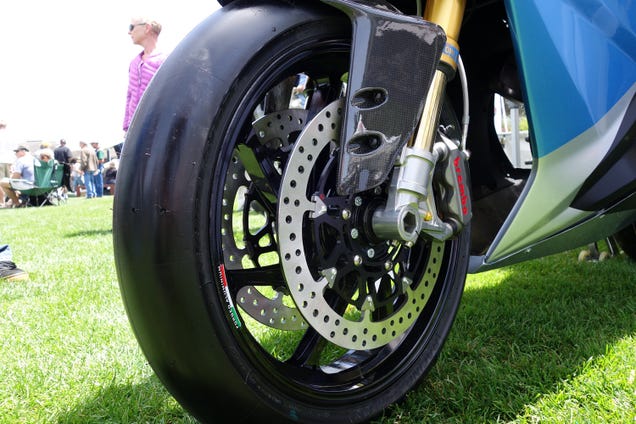Jalopnik.com:
 S
S
There's a difference between building a motorcycle in your shed and bringing an electric hyper-bike to market. Lighting is somewhere in between. They've got racing victories and investment and what seems like solid tech, but there's still a "guy in a garage" vibe that doesn't mesh with my survival instincts at 200 MPH. I want them to prove me wrong.
Now, Lightning has chops. They obliterated Pikes Peak last year, not only kicking their class' ass, but walking away from the gas-powered machines with an incredible 20-second lead. Before that, Lightning set the first land speed record for an electric motorcycle (166 MPH), then broke the 200 MPH barrier two years later when it clocked 215.9 MPH – just a tailwind away from its theoretical 218 MPH top speed.
 1
1
The president and CEO, Richard Hatfield, has been working with electric vehicles for nearly 15 years, starting with a race-prepped electric Porsche 914 before moving on to two wheels.
"It's the perfect platform," Hatfield says about the compact packaging of bikes. Others agree, with Brammo, BRD, Lit, Mission, and Zero all committed to electrifying bikes. And even a few OEMs are looking to finally introduce or expand their electric offerings.
But hardware is hard. Zero has dealt with a spate of recalls, the Brammo line up has barely changed, and we're waiting for the rest to deliver The Next Big Thing or flame out in the process.
Looking at the LS-218, I'm trying to figure out which category it fits in.
 S
S
It's obvious that getting the bike to the Quail Motorcycle event in Carmel, CA was a rush job. While I was walking up, one of the Lightning people was re-screwing an allen bolt into the windscreen. Masking tape was stuck between two pieces of the faring and a few unfinished edges on the body work gave me the sense that I'd have paint on my hands if I touched it.
But everything underneath looked spectacular. The swing arm is milled out of a massive chunk of aluminum and available in carbon fiber. The CNC'd rear subframe should be hanging on my wall. The adjustable Öhlins forks are attached to a pair of 320mm discs with four-piston Brembos, with wheels from Marchesini (think BBS for bikes).

Lightning claims its liquid-cooled electric motor puts out 200 HP and 168 lb-ft of torque, double the twist of a comparable Ducati. Range varies between 120-180 miles per charge, depending on the size battery pack (12, 15, or 20 kWh), and a DC quick charger is on board for a 30-min charge or 2 hours on a 220-volt outlet.
There's no transmission, and when I ask Hatfield about the decision he says, "If you make enough torque to lift the front wheel and slide the rear end you don't need a gearbox." Point taken.
All told, the LS-218 comes in at 495 pounds, considerably heavier than your average Italian exotic. But that's the case for every electric bike, and as Mission Motorcycles proved, you only feel it through low speed corners.
But right now you'd feel nothing. That's because there's no battery. Granted, that's not out of the ordinary for a show bike, but considering the advances Lightning made in racing, I expected a working drivetrain.

With deliveries slated to begin this summer, they don't have much time. Lightning is promising to crank out 55 models in its initial production run, and they have to do it with OEM-level quality and back it up with the tech support to match its $39,000 price tag.
Hatfield knows it.
When I ask him about Lightning's upcoming plans for Pikes Peak and racing, he shakes his head and says, "We're not going. Our challenge now is to sell bikes."
 S
SThere's a difference between building a motorcycle in your shed and bringing an electric hyper-bike to market. Lighting is somewhere in between. They've got racing victories and investment and what seems like solid tech, but there's still a "guy in a garage" vibe that doesn't mesh with my survival instincts at 200 MPH. I want them to prove me wrong.
Now, Lightning has chops. They obliterated Pikes Peak last year, not only kicking their class' ass, but walking away from the gas-powered machines with an incredible 20-second lead. Before that, Lightning set the first land speed record for an electric motorcycle (166 MPH), then broke the 200 MPH barrier two years later when it clocked 215.9 MPH – just a tailwind away from its theoretical 218 MPH top speed.
 1
1The president and CEO, Richard Hatfield, has been working with electric vehicles for nearly 15 years, starting with a race-prepped electric Porsche 914 before moving on to two wheels.
"It's the perfect platform," Hatfield says about the compact packaging of bikes. Others agree, with Brammo, BRD, Lit, Mission, and Zero all committed to electrifying bikes. And even a few OEMs are looking to finally introduce or expand their electric offerings.
But hardware is hard. Zero has dealt with a spate of recalls, the Brammo line up has barely changed, and we're waiting for the rest to deliver The Next Big Thing or flame out in the process.
Looking at the LS-218, I'm trying to figure out which category it fits in.
 S
SIt's obvious that getting the bike to the Quail Motorcycle event in Carmel, CA was a rush job. While I was walking up, one of the Lightning people was re-screwing an allen bolt into the windscreen. Masking tape was stuck between two pieces of the faring and a few unfinished edges on the body work gave me the sense that I'd have paint on my hands if I touched it.
But everything underneath looked spectacular. The swing arm is milled out of a massive chunk of aluminum and available in carbon fiber. The CNC'd rear subframe should be hanging on my wall. The adjustable Öhlins forks are attached to a pair of 320mm discs with four-piston Brembos, with wheels from Marchesini (think BBS for bikes).

Lightning claims its liquid-cooled electric motor puts out 200 HP and 168 lb-ft of torque, double the twist of a comparable Ducati. Range varies between 120-180 miles per charge, depending on the size battery pack (12, 15, or 20 kWh), and a DC quick charger is on board for a 30-min charge or 2 hours on a 220-volt outlet.
There's no transmission, and when I ask Hatfield about the decision he says, "If you make enough torque to lift the front wheel and slide the rear end you don't need a gearbox." Point taken.
All told, the LS-218 comes in at 495 pounds, considerably heavier than your average Italian exotic. But that's the case for every electric bike, and as Mission Motorcycles proved, you only feel it through low speed corners.
But right now you'd feel nothing. That's because there's no battery. Granted, that's not out of the ordinary for a show bike, but considering the advances Lightning made in racing, I expected a working drivetrain.

With deliveries slated to begin this summer, they don't have much time. Lightning is promising to crank out 55 models in its initial production run, and they have to do it with OEM-level quality and back it up with the tech support to match its $39,000 price tag.
Hatfield knows it.
When I ask him about Lightning's upcoming plans for Pikes Peak and racing, he shakes his head and says, "We're not going. Our challenge now is to sell bikes."